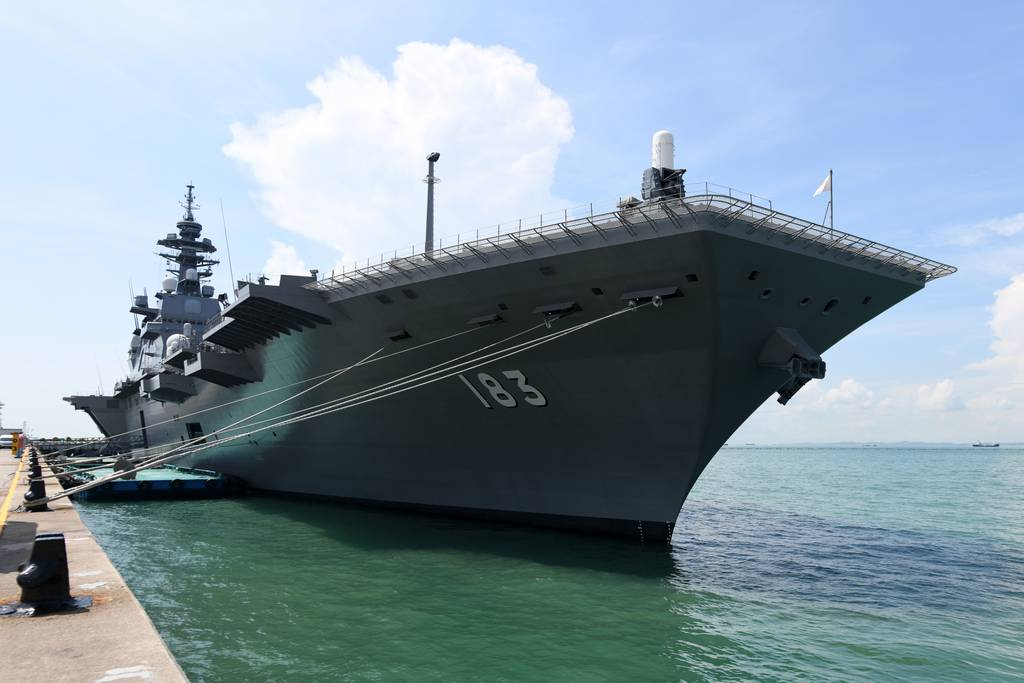Japan sends ship “Izumo” to the world’s largest naval exercise
The US website “Defense News” reported on June 3 that Japan plans to send its recently refitted aircraft carrier “Izumo” to the Indo-Pacific region for deployment. annually, for the next 4 months.
A series of training activities will be carried out, of which the most interesting is the formation led by the Izumo-class Helicopter Destroyer that will participate in the war. exercise The world’s largest navy – Pacific Rim-2022, will be held in Hawaiian waters in June. This will be the first time a Japanese warship participates in the war. exercise Pacific Rim after it has the ability to take off and land on fixed-wing aircraft carriers.
According to the report, the Izumo-class Helicopter Destroyer will be on a deployment in the Indo-Pacific alongside two frigates and an unnamed submarine. The deployment is scheduled from June 13 to October 28. Participating in this deployment are “Izumo” ship-mounted helicopters such as: several JMSDF aircraft, a P-1 maritime patrol aircraft, an UP-3D electronic intelligence training aircraft and a US-2 amphibious aircraft. It is not clear whether the aircraft will follow the formation throughout the deployment or not.

“Izumo” will be deployed in the Indo-Pacific from June 13 to October 28.
Japan, the “biggest foreign customer” of the US F-35, plans to buy 147 aircraft, including 42 of the F-35B vertical take-off/landing versions. In exercise At this point, the “Izumo” ship does not carry an aircraft carrier-based F-35B, but some analysts think it is very likely that the US military’s F-35B fighter will make a series of attacks. exercise Takeoff and landing on the Japanese aircraft carrier “Izumo”.
During this deployment, the Japanese ship “Izumo” will participate in a series of meetings exercise navy, including exercise Pacific Rim multinational was held in the waters near Hawaii in June and the meeting exercise “Kakadu-2022” is held in Australia in September. Other training activities include Exercises Pacific Pioneer-2022 cooperates with the US, Korean and Australian navies, and exercise with the Indian Navy.
In a statement, the Japanese Defense Ministry said the deployment had two goals: “Enhancing the tactical capabilities of the Japan Maritime Self-Defense Forces, strengthening cooperation with partner navies in the region Indo-Pacific region through meetings exercise common ground and enhance mutual understanding and cooperation with partner countries”.
“Izumo” was originally positioned as a Japanese Izumo-class helicopter destroyer. This is the largest ship of the Japan Maritime Self-Defense Force, displacing 27 thousand tons of water. The ship’s long, flat deck measures the length of two and a half football fields at 248 metres. The Izumo normally carries seven SH-60K helicopters designed for sea maneuvers to intercept hostile submarines, along with two other search and rescue models — although it can carry 28 helicopters if necessary, needs. The Izumo also has several lifts to lower the helicopter to the hangar deck inside.
Historically, the Japanese Navy has placed great emphasis on aircraft carriers. The aircraft carrier Hōshō was commissioned on December 27, 1922, as the world’s first aircraft carrier concept. Taking part in the Battle of Midway in June 1942, Japan had the largest aircraft carrier fleet in the world. By the end of the war, many carriers had been sunk, mostly by the United States Navy.
After the war, the remaining aircraft carriers were destroyed and Japan entered a period of disarmament, adopting a Constitution of 1947 that prohibited the maintenance of forces capable of waging war. Between the Korean War and the Cold War, with US support, military capabilities were re-established for self-defense purposes, according to the constitution.
Recently, Japan’s neighboring countries have begun to have aircraft carriers. China is building a large fleet of aircraft carriers. One of them, the aircraft carrier Shandong, passed through the Taiwan Strait with fighter jets on board as a show of strength. South Korea is also planning to build its first jet-equipped aircraft carriers.
Against this backdrop, the understanding of the Constitution’s spirit of Article 9 giving up war has changed under Prime Minister Shinzo Abe. Japan will not have an aircraft carrier, but will have a Multi-Purpose Destroyer. To a knowledgeable person, the difference is only in the name. Two existing “Helicopter” destroyers will be modified to house F-35B fighters.
Japan has begun converting this ship and its sister ship “Kaga” into a light aircraft carrier that can carry the US-made F-35B Lightning II fighter jet, which can take off from short runways. and landed vertically.
On December 18, 2018, the Japanese Cabinet approved a plan to upgrade the Izumo-class ships to equip fixed-wing aircraft. The upgrade program was divided into 2 phases, the first upgrade included: adding a ramp at the end of the runway, increasing air traffic control capacity and improving the runway surface to be able to bear additional weight. complement of the STOVL F-35B jets, as well as the heat and pressure from their engines during vertical landing.
Phase 1 upgrade program will be completed in 2020 (JDS Izumo) and 2021 (JDS Kaga) respectively. The cost of repair and upgrading of this phase is 3.1 billion yen. From 3 to 7 October 2021, within the framework of meetings exercise amphibious landing in the Pacific Ocean, the US Marines’ F-35B aircraft successfully tested the ability to take off and land on board the JDS Izumo DDH-183. This is also the first time a fixed-wing aircraft has operated on a JMSDF warship since World War II.
According to reports, the first phase of the Izumo’s ‘conversion’ process has been completed, the ship will conduct takeoff and landing tests with a US Marine F-35B based in Japan next month. 10 in 2021, making it Japan’s first post-World War II aircraft carrier.
The next phase of the retrofit will include changing the front of the flight deck from a trapezoid to a rectangular one, as well as altering the ship’s interior to accommodate F-35B operations. These changes are mainly intended to increase the space for storing aviation fuel on the aircraft carrier and in-flight weapons.
In the second upgrade, the Izumo-class helicopter destroyer is equipped with the JPALS automatic take-off and landing control system jointly developed by the US Navy and Raytheon Company. JPALS is an all-weather system that automatically guides military aircraft such as the F-35B and Osprey to land safely and accurately using GPS satellite signals and an inertial navigation system. (INS). The cost of the navigation equipment is expected to be 3.6 billion yen, and the cost of technical support from the US Army is 1.2 billion yen. In addition, along with the operation of the F-35B, the interior compartments will also be improved during this period.
at Blogtuan.info – Source: danviet.vn – Read the original article here



